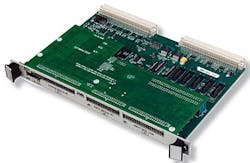Navy chooses NTDS boards from L3 IEC to bridge legacy shipboard computers to VME
Officials of the Space and Naval Warfare Systems Command (SPAWAR) in San Diego, have announced plans to award a sole-source contract to L3 IEC for NTDS Type-E interface cards.
L3 IEC provides the Antares NTDS I/O board, which provides a direct interface between legacy Navy NTDS-based computers and the industry-standard VME bus. NTDS is a legacy Navy shipboard data network. On new ships it is being phased out in favor of more modern networks like Ethernet.
NTDS Type-E provides asynchronous serial data transfer at 10 megabits per second with 300,000 words per second in burst mode, or 175,000 words per second in single transfer mode. Type E uses Bi-Phase Modulation [Manchester II phase encoding].
The L3 IEC Antares NTDS boards are for intelligent NTDS I/O protocol control that help users transfer and manipulate I/O data, test and set host processor semaphores, and service VME bus interrupts in response to I/O events.
The boards help users carry out complex NTDS protocols without accessing the host processors. As many as 19 L3 IEC Antares NTDS boards can fit in one VME chassis with one or more processors.
The Antares boards enable users to transfer data on all four NTDS I/O paths -- input, output, external function, and external interrupt -- at the same time. The boards can activate and transfer an external function word on an inter-computer channel while an output transfer is active.
I/O chains from legacy Navy AN/UYK-43, -7, -44, and -20 computers can be ported to execute on the Antares NTDS boards to bridge between legacy military computers and industry-standard open-systems computers.
The number of boards and the amount of the upcoming SPAWAR contract to L3 IEC have yet to be negotiated. SPAWAR leaders call their command the Navy’s information dominance systems command and technical lead for command, control, communications, computers, intelligence, and reconnaissance (C4ISR).
As such, SPAWAR provides the hardware and software to connect Navy and Marine Corps warfighters at sea, on land, and in the air, and support the lifecycle of products and services from initial research, to acquisition, and through logistics support.
For more information contact L3 IEC online at www2.l-3com.com/iec, or SPAWAR at www.spawar.navy.mil.
